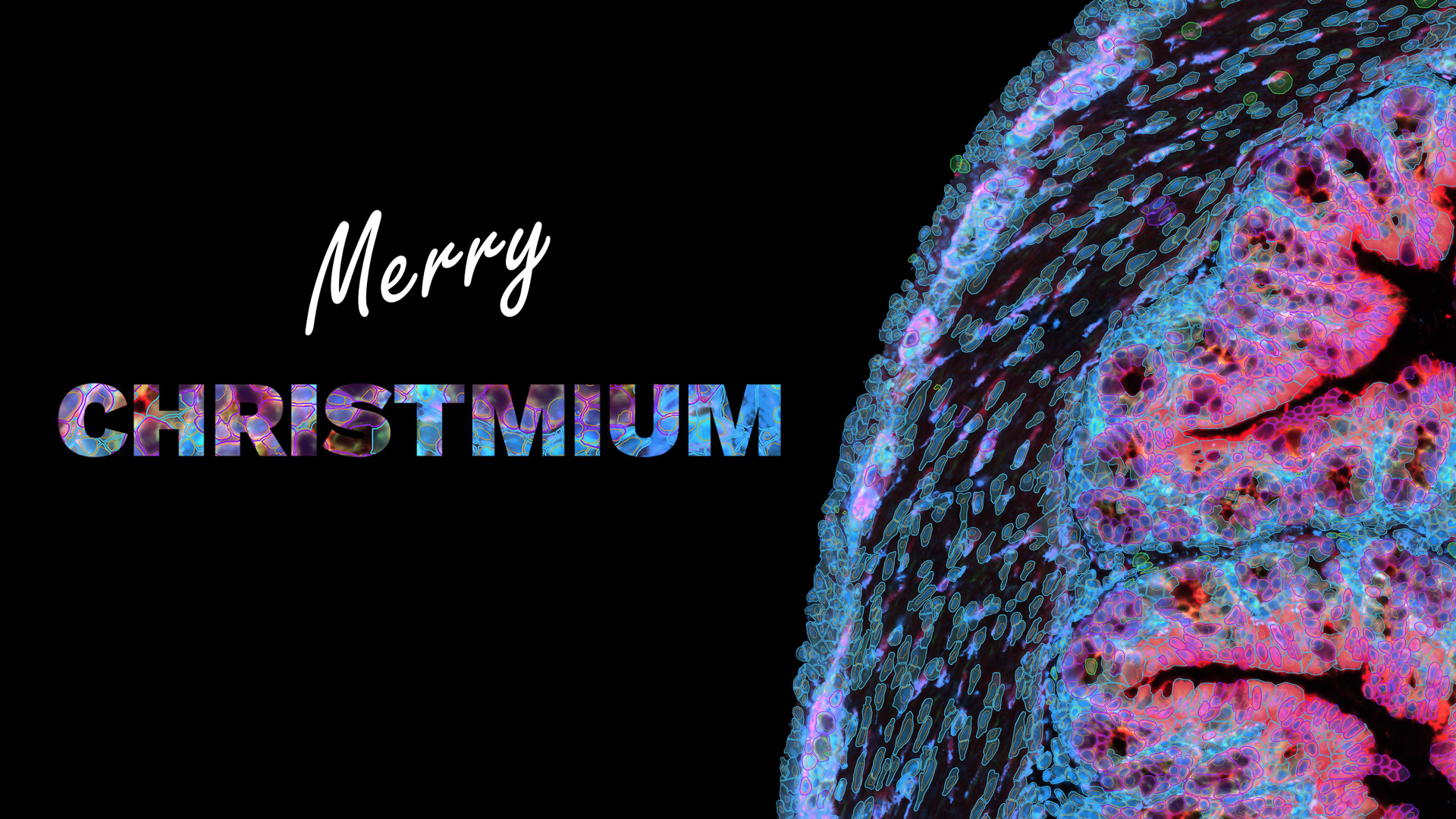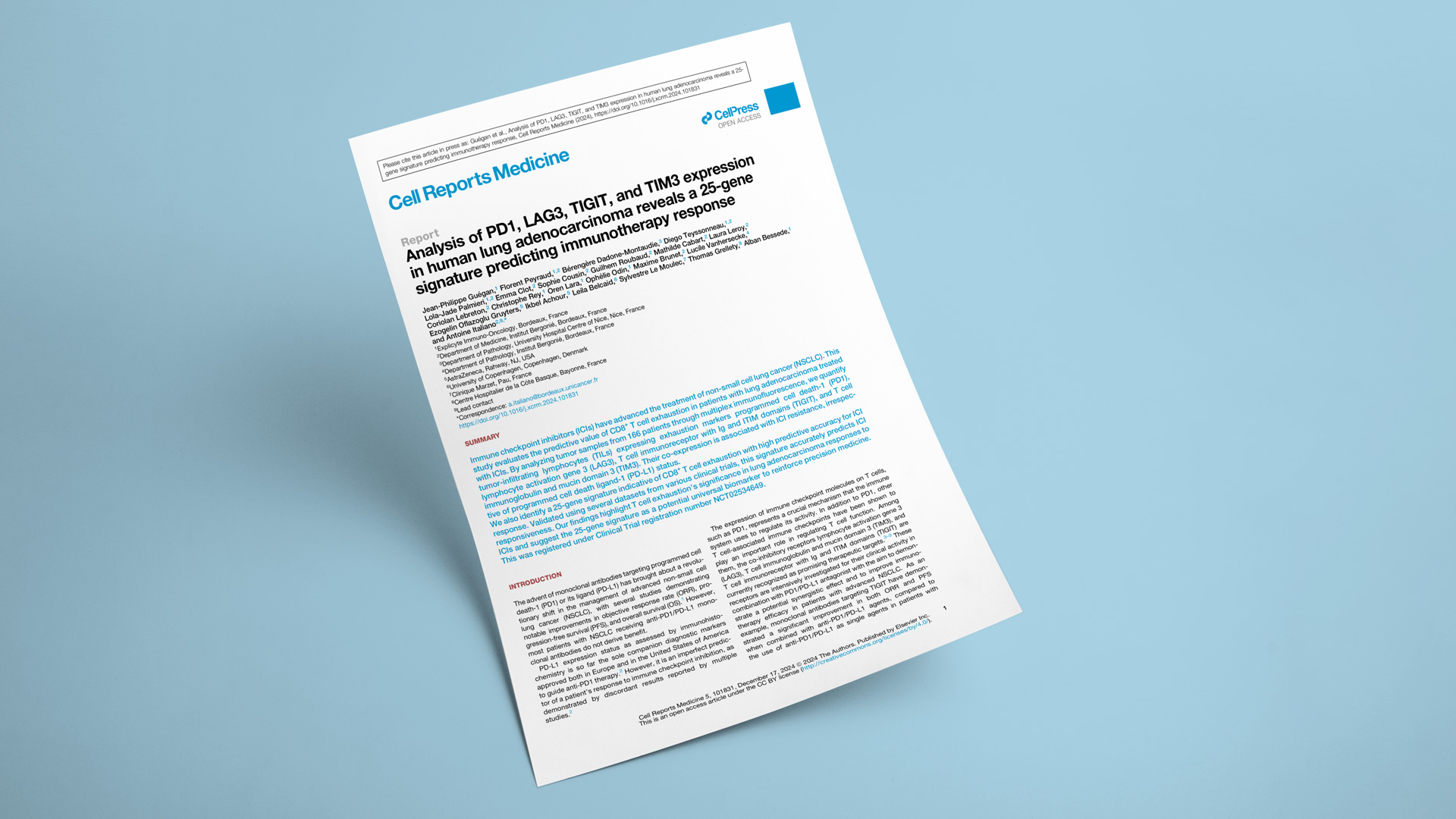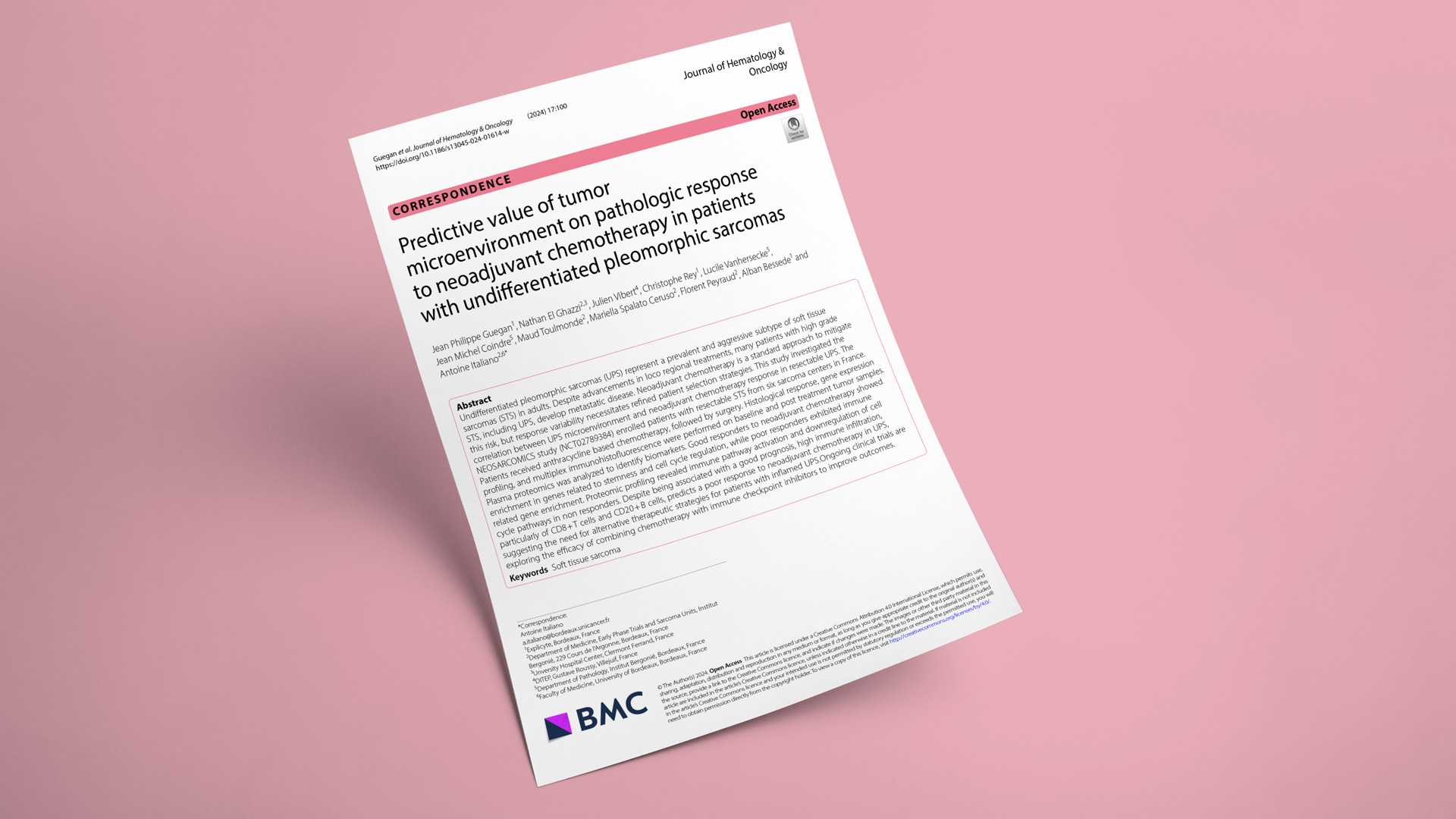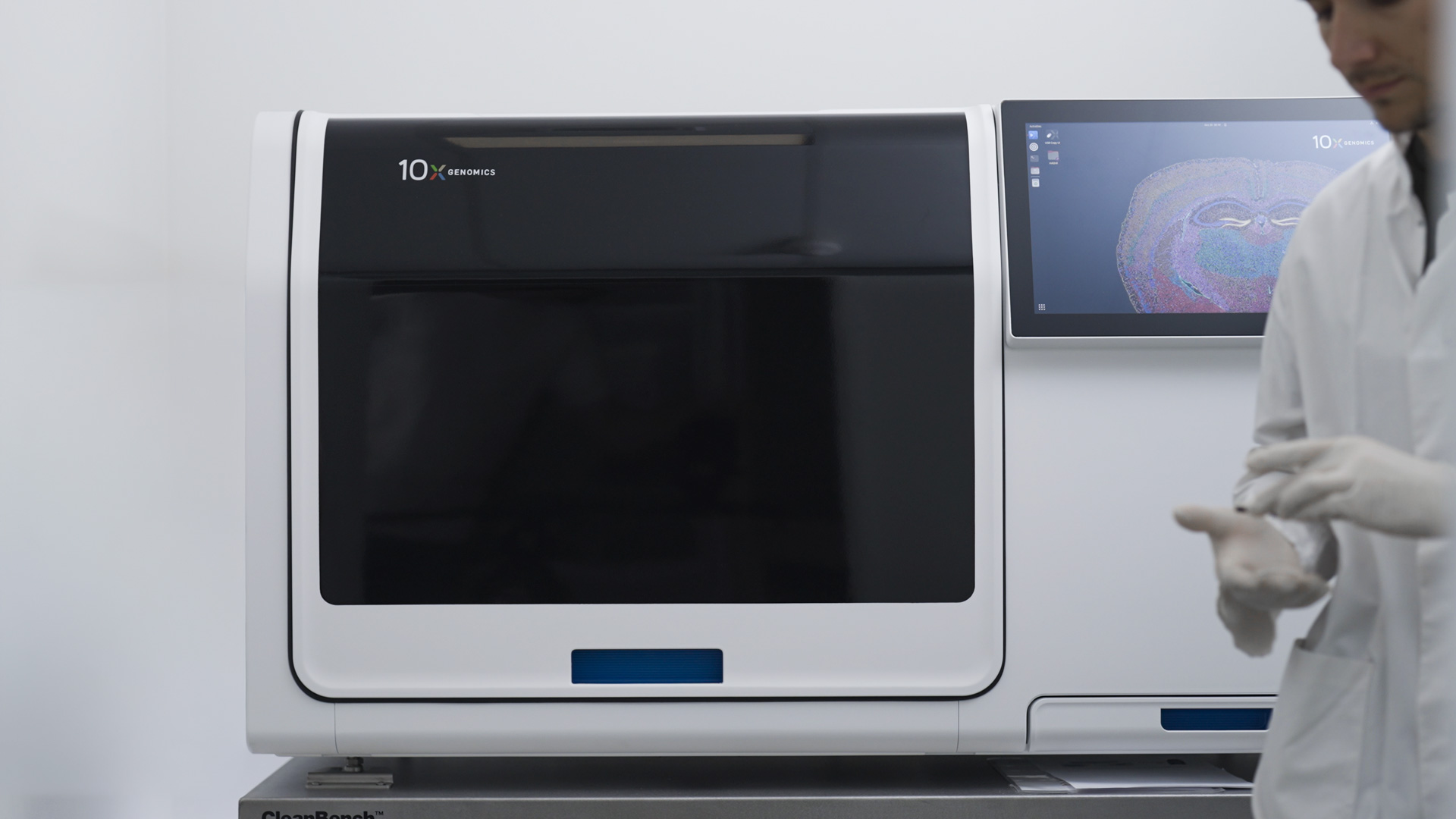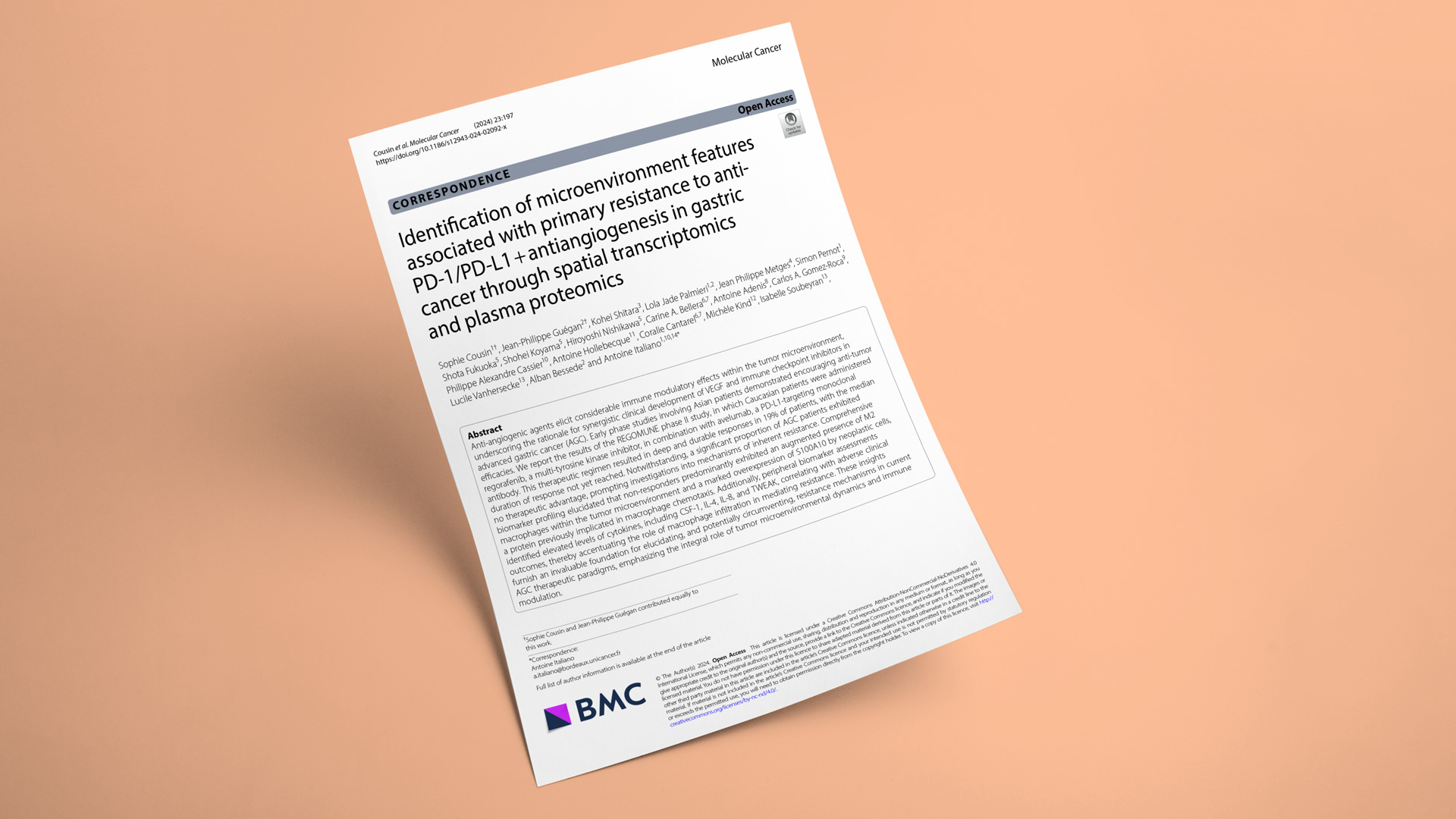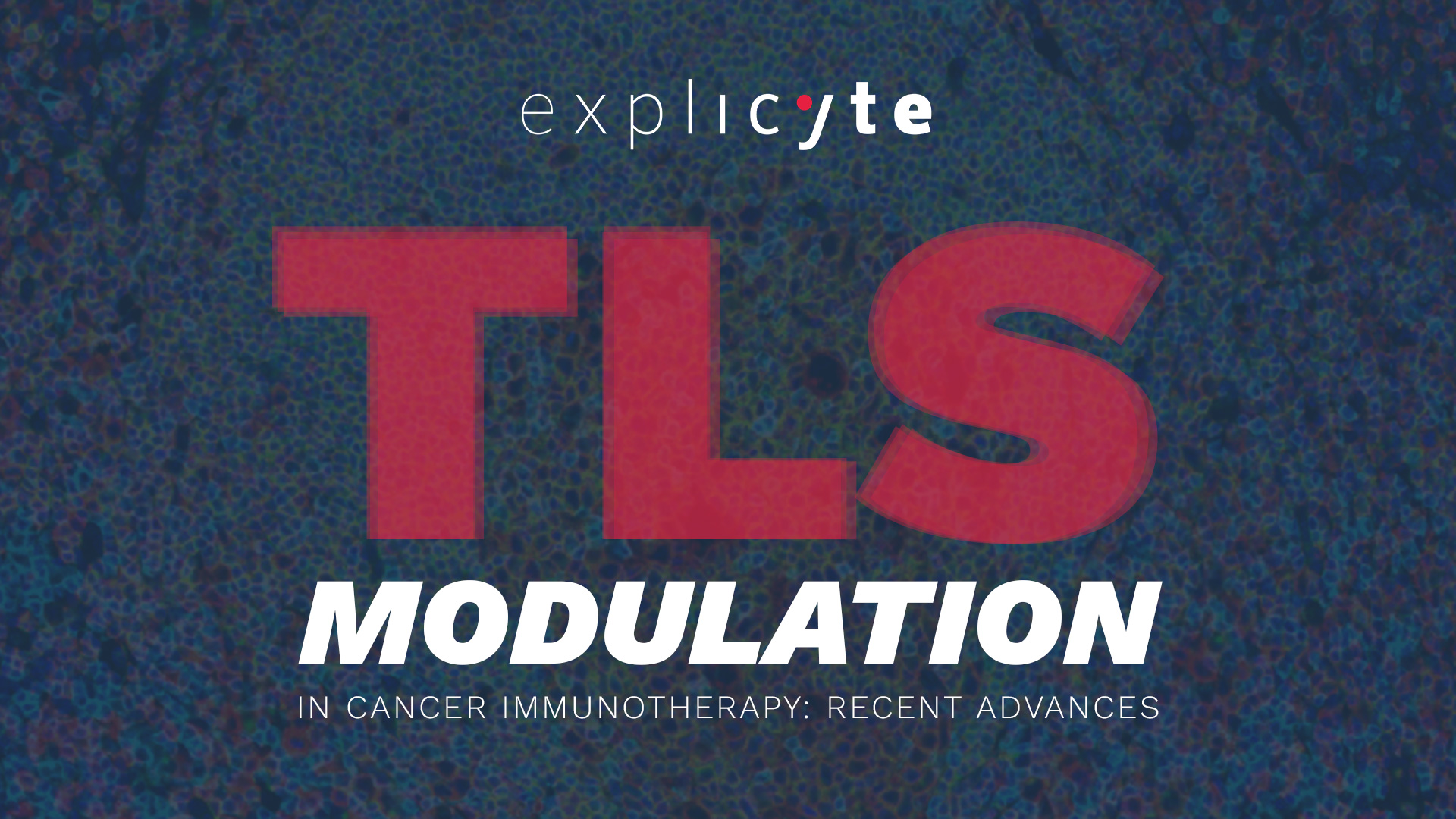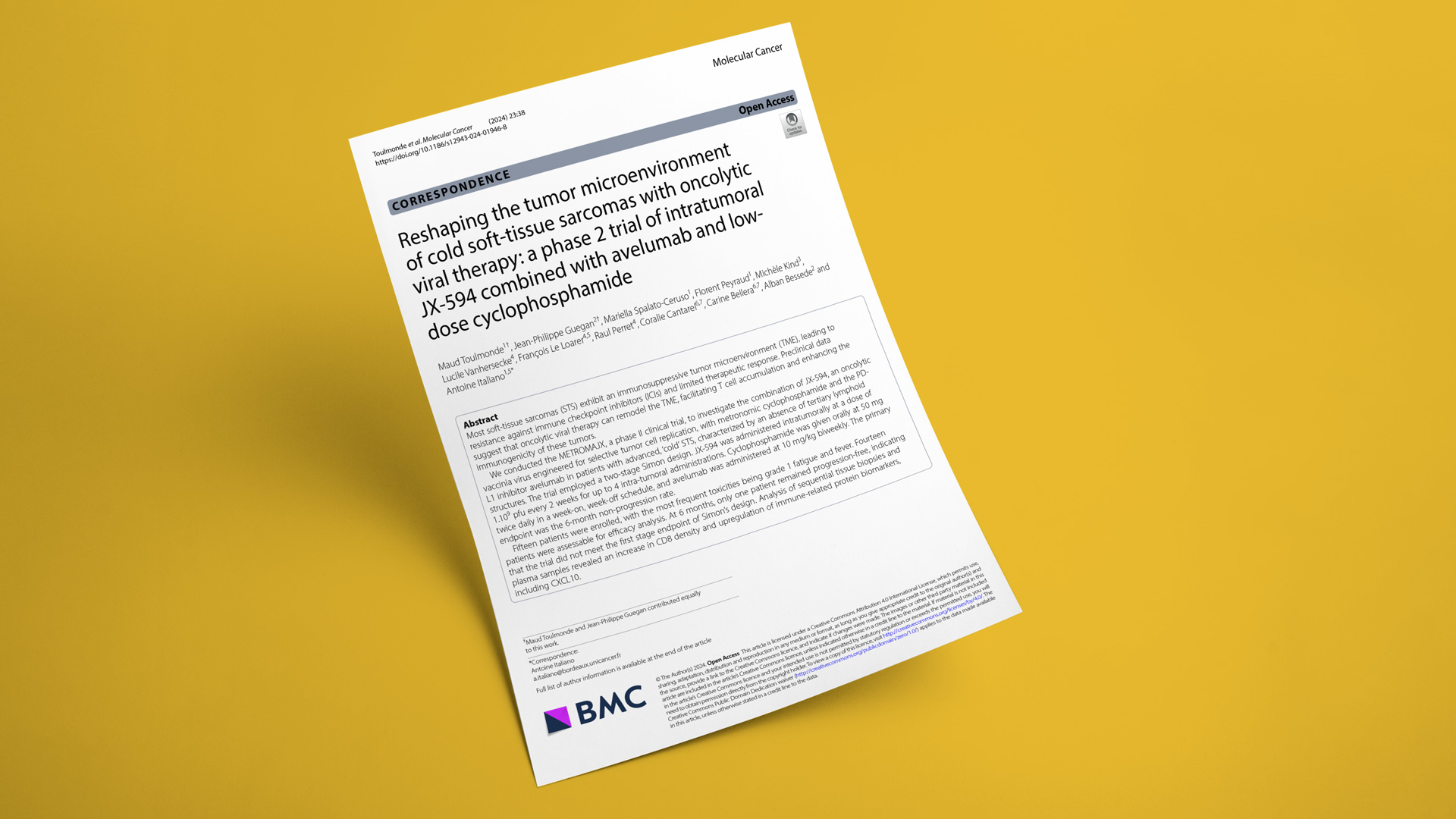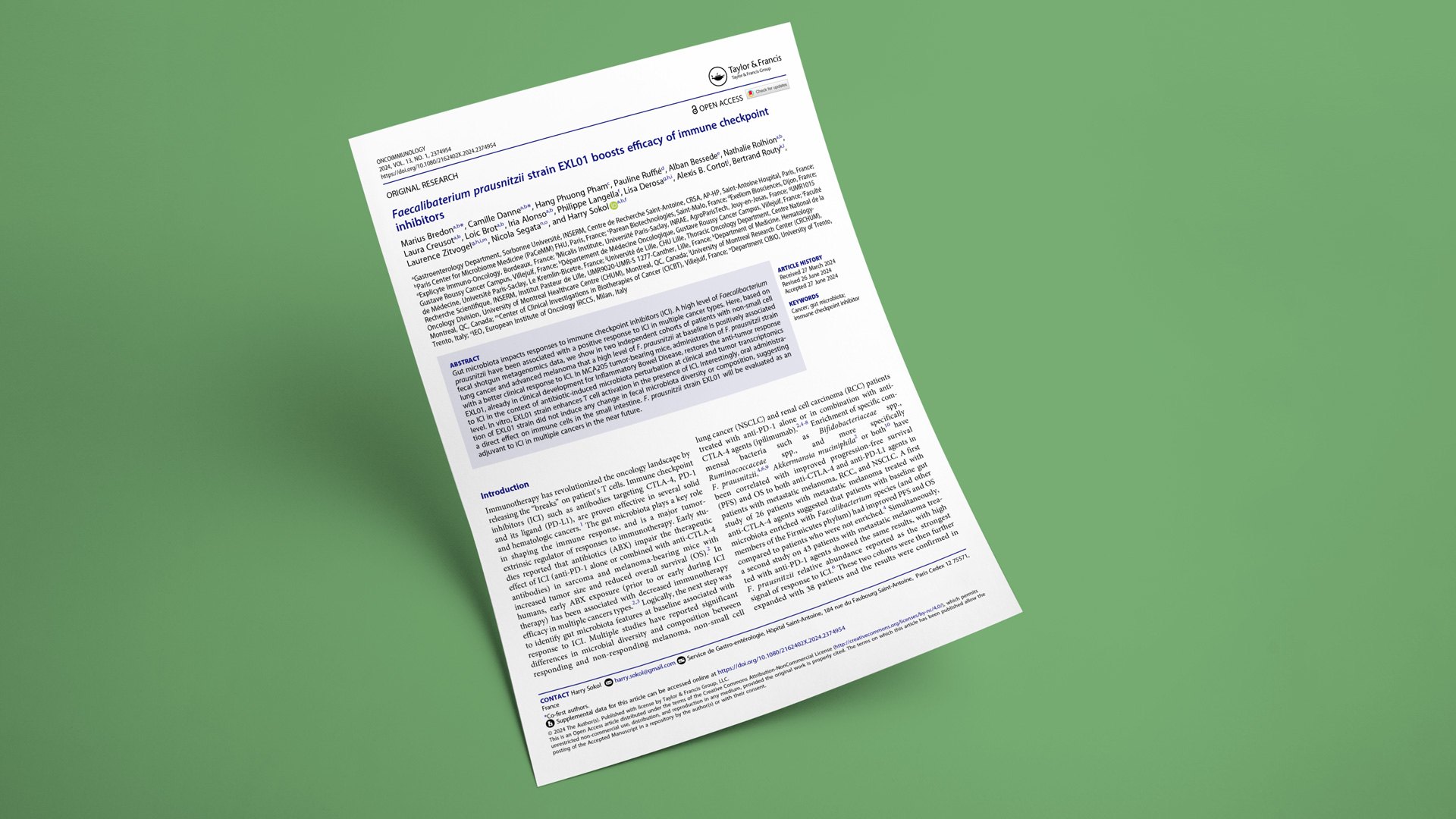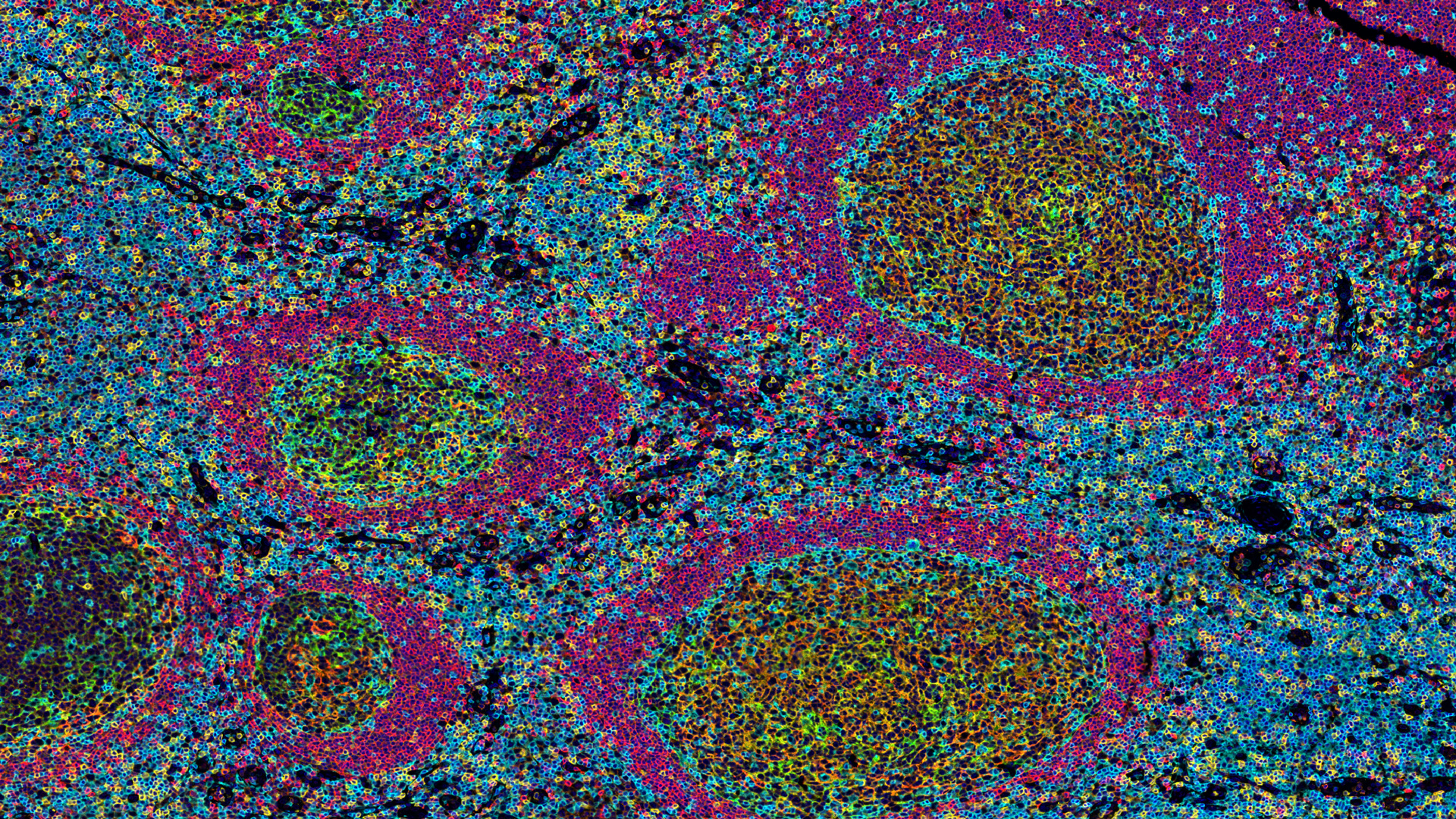This retrospective work, led by Prof. Antoine Italiano (Bergonié Comprehensive Cancer Center) and funded by AstraZeneca and the Nouvelle-Aquitaine Regional Council, is based on the BIP study (NCT02534649). It seeks to evaluate the predictive value of CD8+ T cell exhaustion in lung adenocarcinoma patients treated with immune checkpoint inhibitors.
Assessment of TIL Exhaustion by Multiplex Immunohistofluorescence (mIHF)
Explicyte applied a panel indicative of tumor-infiltrating lymphocyte (TIL) exhaustion (CD8, CK7, LAG3, PD1, TIGIT, and TIM3) to tumor samples from 166 patients with advanced lung adenocarcinoma, collected before their treatment with anti-PD1/PD-L1 immunotherapy. Our mIHF analysis revealed that non-responders featured a high proportion of CD8+ T cells co-expressing PD1 and at least one other marker of exhaustion (LAG3, TIGIT, or TIM3). This profile was associated with poorer clinical outcomes, independently of other factors such as age, gender, and PD-L1 status assessed by IHC.
Whole Transcriptome Analysis Reveals a 25-Gene Signature Predictive of CD8+ T Cell Exhaustion and Response to Immunotherapy
Our translational team then analyzed a total of 135 FFPE samples - characterized for their exhaustion status by mIHF - using the HTG transcriptome panel (19,000+ targets). From this analysis, we identified a 25-gene transcriptomic signature strongly associated with the exhaustion phenotype, demonstrating high predictive accuracy. The robustness of this signature was validated in external datasets from NSCLC clinical trials (POPLAR [NCT02517892], OAK [NCT0200822], and MATCH-R [NCT02517892]).
The Predictive Value of the 25-Gene Exhaustion Signature Extends Beyond Lung Cancer
Datasets from the CA209-038 melanoma trial (NCT01621490) and the JAVELIN Renal 101 (NCT0268400601) trial in renal carcinoma confirmed the robustness of the CD8+ T cell exhaustion signature as a biomarker for stratifying patients likely to benefit from immunotherapy.
Assessment of TIL Exhaustion by Multiplex Immunohistofluorescence (mIHF)
Explicyte applied a panel indicative of tumor-infiltrating lymphocyte (TIL) exhaustion (CD8, CK7, LAG3, PD1, TIGIT, and TIM3) to tumor samples from 166 patients with advanced lung adenocarcinoma, collected before their treatment with anti-PD1/PD-L1 immunotherapy. Our mIHF analysis revealed that non-responders featured a high proportion of CD8+ T cells co-expressing PD1 and at least one other marker of exhaustion (LAG3, TIGIT, or TIM3). This profile was associated with poorer clinical outcomes, independently of other factors such as age, gender, and PD-L1 status assessed by IHC.
Whole Transcriptome Analysis Reveals a 25-Gene Signature Predictive of CD8+ T Cell Exhaustion and Response to Immunotherapy
Our translational team then analyzed a total of 135 FFPE samples - characterized for their exhaustion status by mIHF - using the HTG transcriptome panel (19,000+ targets). From this analysis, we identified a 25-gene transcriptomic signature strongly associated with the exhaustion phenotype, demonstrating high predictive accuracy. The robustness of this signature was validated in external datasets from NSCLC clinical trials (POPLAR [NCT02517892], OAK [NCT0200822], and MATCH-R [NCT02517892]).
The Predictive Value of the 25-Gene Exhaustion Signature Extends Beyond Lung Cancer
Datasets from the CA209-038 melanoma trial (NCT01621490) and the JAVELIN Renal 101 (NCT0268400601) trial in renal carcinoma confirmed the robustness of the CD8+ T cell exhaustion signature as a biomarker for stratifying patients likely to benefit from immunotherapy.
Read paper
Imane Nafia, PhD, Chief Scientific Officer of Explicyte, will attend AACR IO in Los Angeles (Feb. 23-26).
Contact us to arrange a meeting on-site
Contact us to arrange a meeting on-site
In this retrospective study led by Pr. Antoine Italiano (Bergonié & Gustave Roussy Comprehensive Cancer Centers) based on the NEOSARCOMICS trial, we investigated whether microenvironment features of undifferentiated pleomorphic sarcomas (UPS) - an aggressive subtype of soft tissue sarcoma - could predict response to neoadjuvant anthracycline-based chemotherapy.
These results suggest that immune infiltration status can serve to stratify UPS patients before surgical resection. Patients with high immune infiltration benefit from a better prognosis from the start and may respond poorly to chemotherapy. However, neoadjuvant therapy may improve the prognosis of immune-low UPS patients.
- Microenvironment features & prognosis without neoadjuvant therapy: We applied a multiplexed immunohistofluorescence (mIHF) panel on tumor samples from 47 patients with UPS who underwent surgical resection. We found that patients with poor survival had fewer infiltrated immune cells (especially CD8+ cells and M1 macrophages), while patients with better overall survival tended to feature high tumor infiltration.
- Microenvironment features & response to neoadjuvant therapy: We then analyzed the gene expression of baseline samples from 24 patients with resectable UPS, who were treated with neoadjuvant chemotherapy. We found that a good response was associated with a high proliferation and low immune infiltration phenotype. This finding was confirmed with the multiplex mIHF panel: patients who poorly respond to neoadjuvant therapy feature high immune infiltration. Plasma proteomics confirmed the upregulation of cell cycle pathways in low immune infiltration patients.
These results suggest that immune infiltration status can serve to stratify UPS patients before surgical resection. Patients with high immune infiltration benefit from a better prognosis from the start and may respond poorly to chemotherapy. However, neoadjuvant therapy may improve the prognosis of immune-low UPS patients.
Read paper in the Journal Hematology & Oncology
Explicyte is the first immuno-oncology CRO in Europe equipped with the 10x Xenium platform for single-cell spatial transcriptomics! Training by the 10x Genomics team started! Why is it exciting for immuno-oncology?
“For our translational and data science team, the Xenium platform opens unexplored avenues for analyzing tumors and their microenvironment in response to various cancer modalities, including immunotherapies.
For our sponsors, gaining a deep understanding of the gene expression profiles and spatial distribution of individual cells within a tumor specimen can provide unique insights into understanding tumor biology, and mechanisms at play in anti-cancer response or resistance to treatment. It creates opportunities to identify new targets and biomarkers to predict clinical outcomes for cancer patients.
As a researcher, I’m eager to watch tumor cells, immune cells, cancer-associated fibroblasts with the Xenium eye, and to witness the single-cell architecture of immune infiltrates and tertiary lymphoid structures. We are truly excited as we enter a new era of cancer discovery."
Alban Bessede, CEO of Explicyte Immuno-Oncology.
About the 10x Xenium platform:
Learn about our services for target identification & biomarker discovery in immuno-oncology.
“For our translational and data science team, the Xenium platform opens unexplored avenues for analyzing tumors and their microenvironment in response to various cancer modalities, including immunotherapies.
For our sponsors, gaining a deep understanding of the gene expression profiles and spatial distribution of individual cells within a tumor specimen can provide unique insights into understanding tumor biology, and mechanisms at play in anti-cancer response or resistance to treatment. It creates opportunities to identify new targets and biomarkers to predict clinical outcomes for cancer patients.
As a researcher, I’m eager to watch tumor cells, immune cells, cancer-associated fibroblasts with the Xenium eye, and to witness the single-cell architecture of immune infiltrates and tertiary lymphoid structures. We are truly excited as we enter a new era of cancer discovery."
Alban Bessede, CEO of Explicyte Immuno-Oncology.
About the 10x Xenium platform:
- Compatible with standard tumor specimens (frozen & FFPE)
- TME architecture is visualized at subcellular level with a 5000-gene panel
- Single-cell analysis & segmentation with AI-driven algorithm
Learn about our services for target identification & biomarker discovery in immuno-oncology.
In this study led by Pr. Antoine Italiano (Bergonié & Gustave Roussy Comprehensive Cancer Centers), 49 patients with advanced gastric cancer were treated with avelumab (a PD-1/PD-L1 inhibitor) in combination with the anti-angiogenic drug regorafenib (a multi-kinase tyrosine inhibitor). Despite encouraging efficacy results, a significant subset of patients did not respond to this therapeutic regimen.
Explicyte utilized spatial transcriptomics to profile the expression of over 18,000 protein-coding genes across six tumors from both responding and non-responding patients from the REGOMUNE & REGONIVO studies (both combining regorafenib with immune checkpoint inhibition). In the immune compartments of resistant patients, the CD163 gene was found to be overexpressed, alongside an enrichment in M2 macrophages. Non-responding patients also exhibited a strong upregulation of the S100A10 protein in tumor cells—a protein involved in macrophage chemotaxis.
We then developed two immunohistofluorescence (IHF) panels to validate these findings via digital pathology in 43 tumor biopsies. The results confirmed the abundance of M2 macrophages in resistant patients, with a significant increase in the M2/M1 ratio, and the overexpression of S100A10 in tumor cells among patients with poor responses.
Finally, plasma biomarkers were investigated using an Olink proteomic panel. Several cytokines (CSF-1, IL-4, IL-8, and TWEAK) associated with macrophage infiltration were found to be upregulated in patients with worse outcomes.
Altogether, this paper highlights the central role of M2 macrophages in the resistance to anti-PD-1/PD-L1 immunotherapy combined with anti-angiogenic therapy in gastric cancers and provides perspectives for novel diagnostic and therapeutic approaches.
Explicyte utilized spatial transcriptomics to profile the expression of over 18,000 protein-coding genes across six tumors from both responding and non-responding patients from the REGOMUNE & REGONIVO studies (both combining regorafenib with immune checkpoint inhibition). In the immune compartments of resistant patients, the CD163 gene was found to be overexpressed, alongside an enrichment in M2 macrophages. Non-responding patients also exhibited a strong upregulation of the S100A10 protein in tumor cells—a protein involved in macrophage chemotaxis.
We then developed two immunohistofluorescence (IHF) panels to validate these findings via digital pathology in 43 tumor biopsies. The results confirmed the abundance of M2 macrophages in resistant patients, with a significant increase in the M2/M1 ratio, and the overexpression of S100A10 in tumor cells among patients with poor responses.
Finally, plasma biomarkers were investigated using an Olink proteomic panel. Several cytokines (CSF-1, IL-4, IL-8, and TWEAK) associated with macrophage infiltration were found to be upregulated in patients with worse outcomes.
Altogether, this paper highlights the central role of M2 macrophages in the resistance to anti-PD-1/PD-L1 immunotherapy combined with anti-angiogenic therapy in gastric cancers and provides perspectives for novel diagnostic and therapeutic approaches.
Read paper in Molecular Cancer
Since 2021, Explicyte has developed a specific expertise in Tertiary Lymphoid Structure (TLS) detection and scoring by digital pathology. Hosted by Alban Bessede, PhD, CEO of Explicyte, this 45-minute webinar dedicated to TLS modulation in cancer immunotherapy will feature 2 presentations:
Following a PhD thesis on intratumoral T cells at Johns Hopkins in 2010, Tullia Bruno started working on the role of B cells in the TME during her postdoctoral fellowship at the University of Colorado Denver. In 2015, she joined the University of Pittsburgh as an Assistant Professor to investigate the role of intratumoral B cell function within TLS in solid tumors. Focused on translational research and the development of novel immunotherapies, she is also a faculty member in the Tumor Microenvironment Center and the Cancer Immunology and Immunotherapy Program at the UPMC Hillman Cancer Center.
Author of 500+ peer-reviewed publications, Pr. Italiano has been the Principal Investigator of 50+ clinical trials over the past 5 years, investigating the resistance mechanisms to cancer immunotherapies in solid tumors. Trained as a medical oncologist in France, he obtained a PhD in Molecular & Cell Biology in 2008. He then joined the laboratory of Cristina Antonescu for a post-doctoral fellowship at the MSKCC (New York, USA). He is currently leading Early Phase Trials and Sarcoma Units at Institut Bergonié (Bordeaux, France) and the head of the Precision Medicine unit at Gustave Roussy (Villejuif, France).
More about Explicyte's capacities for TLS detection & scoring in patient specimens
Tertiary lymphoid structures as modulators of anti-tumor immunity: what do we know and where are we headed?
Tullia C. Bruno, PhD - UPMC Hillman Cancer Center / University of Pittsburgh
Following a PhD thesis on intratumoral T cells at Johns Hopkins in 2010, Tullia Bruno started working on the role of B cells in the TME during her postdoctoral fellowship at the University of Colorado Denver. In 2015, she joined the University of Pittsburgh as an Assistant Professor to investigate the role of intratumoral B cell function within TLS in solid tumors. Focused on translational research and the development of novel immunotherapies, she is also a faculty member in the Tumor Microenvironment Center and the Cancer Immunology and Immunotherapy Program at the UPMC Hillman Cancer Center.
Predictive role of TLS for cancer immunotherapy: current insights and perspectives
Pr Antoine Italiano, MD, PhD - Institut Bergonié & Gustave Roussy Comprehensive Cancer Centers
Author of 500+ peer-reviewed publications, Pr. Italiano has been the Principal Investigator of 50+ clinical trials over the past 5 years, investigating the resistance mechanisms to cancer immunotherapies in solid tumors. Trained as a medical oncologist in France, he obtained a PhD in Molecular & Cell Biology in 2008. He then joined the laboratory of Cristina Antonescu for a post-doctoral fellowship at the MSKCC (New York, USA). He is currently leading Early Phase Trials and Sarcoma Units at Institut Bergonié (Bordeaux, France) and the head of the Precision Medicine unit at Gustave Roussy (Villejuif, France).
More about Explicyte's capacities for TLS detection & scoring in patient specimens
Register for the webinar
In soft tissue sarcomas, the presence of tertiary lymphoid structures (TLS) is known to increase sensitivity to immune checkpoint inhibitors. In a clinical trial conducted at the Institut Bergonié, Prof. Antoine Italiano and colleagues studied the combination of an oncolytic virus and metronomic chemotherapy with the aim of remodeling the tumor microenvironment of patients with TLS-negative soft-tissue sarcoma, thereby improving their sensitivity to the PD-L1 inhibitor Avelumab.
As part of this study, tumor biopsies and plasma samples were supported and processed by Explicyte teams, for staining and Olink-based proteomics, respectively. Our results confirm that intratumoral administration of the oncolytic virus JX-584 can alter the immune landscape of the tumor microenvironment, potentially converting cold tumors into immunogenic tumors.
As part of this study, tumor biopsies and plasma samples were supported and processed by Explicyte teams, for staining and Olink-based proteomics, respectively. Our results confirm that intratumoral administration of the oncolytic virus JX-584 can alter the immune landscape of the tumor microenvironment, potentially converting cold tumors into immunogenic tumors.
Read the article
New paper : Faecalibaterium prausnitzii strain EXL01 boosts efficacy of immune checkpoint inhibitors
We're happy to showcase a collaboration just published in OncoImmunology. Since 2016, French biotech Exeliom Bioscience has been advancing therapeutic programs targeting the gut microbiota in Crohn's disease and various types of cancer, based on the immuno-modulatory bacterium Faecalibacterium prausnitzii (oral drug EXL01). In this paper, we supported Exeliom Bioscience in the generation of in vivo and vitro data to decipher the mechanism of action of EXL01.
The in vivo study, based on the MCA205 syngeneic tumor model, demonstrates that oral supplementation with EXL1 restores the efficacy of anti-PD-L1 immunotherapy in animals with antibiotics-induced gut dysbiosis. The subsequent in vitro investigation, based on the MLR assay, showed that the EXL1 strain boosts the activation of both dendritic cells and T cells in the presence of anti-PD-L1 antibody.
The in vivo study, based on the MCA205 syngeneic tumor model, demonstrates that oral supplementation with EXL1 restores the efficacy of anti-PD-L1 immunotherapy in animals with antibiotics-induced gut dysbiosis. The subsequent in vitro investigation, based on the MLR assay, showed that the EXL1 strain boosts the activation of both dendritic cells and T cells in the presence of anti-PD-L1 antibody.
Read the paper
From the 8th to the 14th of September, Gregory Lebras will run 330km in the Aosta Valley, in Italy. Enlisted for the TOR330 - TOR DES GÉANTS ultra-endurance trail together with 1,100 competitors, this anesthetist nurse at the Institut Bergonié Comprehensive Cancer Center aims to raise funds to support sarcoma research. Over 7 days, he will encourage his audience to make donations to the not-for-profit association "La Course du Petit Prince".
"We actively participate in the RHU Condor, a research consortium that receives funds from "La Course du Petit Prince" for the development of novel immunotherapies against soft-tissue sarcoma. So when we learned about the initiative of Gregory, we felt compelled to be part of it. Gregory is currently running over 10h per week, he's dedicated, fun, and generous. It just clicked. I can tell we are very proud sponsors !" Alban Bessede, CEO of Explicyte.
https://youtu.be/ejnRb2Acr3Y?si=qovB7lJ2FTELxqxj
"We actively participate in the RHU Condor, a research consortium that receives funds from "La Course du Petit Prince" for the development of novel immunotherapies against soft-tissue sarcoma. So when we learned about the initiative of Gregory, we felt compelled to be part of it. Gregory is currently running over 10h per week, he's dedicated, fun, and generous. It just clicked. I can tell we are very proud sponsors !" Alban Bessede, CEO of Explicyte.
https://youtu.be/ejnRb2Acr3Y?si=qovB7lJ2FTELxqxj
Make a donation
Alban Bessede, CEO of Explicyte, and Antoine Italiano, MD at the Institut Bergonié, were in Chicago in early June at the 2024 ASCO meeting to present a recent piece of research performed in partnership with 3 French Comprehensive Cancer Centers: Institut Gustave Roussy (Paris), Institut Bergonié (Bordeaux), and Institut Claudius Regaud (Toulouse).
In this phase II trial of Regorafenib (anti-VEGFR therapy) combined with avelumab (anti-PD-L1 immunotherapy) in soft-tissue sarcoma patients with cold tumors (TLS-negative), we found a positive effect of this combotherapy in terms of anti-tumor immunity mobilization and 6-month progression-free survival (PFS).
In this phase II trial of Regorafenib (anti-VEGFR therapy) combined with avelumab (anti-PD-L1 immunotherapy) in soft-tissue sarcoma patients with cold tumors (TLS-negative), we found a positive effect of this combotherapy in terms of anti-tumor immunity mobilization and 6-month progression-free survival (PFS).
Read abstract
Over the past 5 years, our translational team released major papers in the field of cancer immunotherapy, in collaboration with French oncologists from the Institut Bergonié and Gustave Roussy Comprehensive Cancer Centers. Here are 5 key papers to highlight what we've learned:
In patients with advanced Non-Small Cell Lung Cancer (NSCLC) treated with PD-L1 inhibitor atezolizumab, the overexpression of trophoblast cell surface antigen 2 (TROP2) is associated with poorer progression-free survival. TROP2High patients are more likely to benefit from a combination of immunotherapy and anti-TROP2 agents.
Technologies used: Plasma Proteomics, Bulk Transcriptomics, Digital Pathology (IF), Spatial Transcriptomics
Read paper
By analyzing NSCLC tumor samples from 891 patients treated with immune checkpoint inhibitors or chemotherapy, we evidenced that IDO1 expression was associated with a favorable clinical outcome (ORR, PFS, OS) upon ICI but not chemotherapy. We also demonstrated that IDO1 is overexpressed within inflamed tumors and noticeably in Tertiary Lymphoid Structures (TLS). These results strongly suggest that targeting the immunosuppressive IDO1 enzyme could be beneficial in patients with inflamed tumors.
Technologies used: T-cell Killing Assay, Germinal Center Reaction Assay, Bulk Transcriptomics, Digital Pathology (IHC/IF), Spatial Transcriptomics
Read paper
Metabolomic analysis of plasma samples collected before cancer patients underwent immunotherapy revealed that the presence of Acetaminophen (APAP) correlates with a limited response to immune checkpoint blockade. This negative impact was validated in two independent prospective cohorts and further strengthened by preclinical evidence, both in vitro and in vivo. Altogether, our findings suggest that the use of Acetaminophen, one of the most widely used drugs, limits cancer immunotherapy efficacy and should be taken with caution.
Technology used: Flow cytometry, Plasma Proteomics, In Vitro Assays, In Vivo Experiments
Read paper
We analyzed the presence of Tertiary Lymphoid Structures (TLS) in tumor samples from 328 patients with solid tumors treated with anti-PD1 or anti-PD-L1 monoclonal antibodies. We found that the presence of mature TLS is predictive of improved clinical outcome (objective response, progression-free survival, overall survival).
Technology used: Digital Pathology
Read paper
Using Olink-based proteomics, we analyzed the plasma samples of 387 patients with advanced cancer treated with immune checkpoint inhibitors. High levels of Leukemia inhibitory factor (LIF) emerged as indicative of poor clinical outcome. The study identifies LIF as a potential target to improve the efficacy of cancer immunotherapies.
Technology used: Plasma Proteomics
Read paper
That's it for now! If you wish to get a full picture of our scientific production, please take a look here.
And if you have a translational research project in mind, let's talk about it. We'll be happy to help.
In Clinical Cancer Research (2024): TROP2 is a biomarker of resistance to immune checkpoint inhibition in NSCLC
In patients with advanced Non-Small Cell Lung Cancer (NSCLC) treated with PD-L1 inhibitor atezolizumab, the overexpression of trophoblast cell surface antigen 2 (TROP2) is associated with poorer progression-free survival. TROP2High patients are more likely to benefit from a combination of immunotherapy and anti-TROP2 agents.
Technologies used: Plasma Proteomics, Bulk Transcriptomics, Digital Pathology (IF), Spatial Transcriptomics
Read paper
In Clinical Cancer Research (2023): IDO1 is a potential therapeutic target for NSCLC patients with inflamed tumor microenvironment and/or TLS
By analyzing NSCLC tumor samples from 891 patients treated with immune checkpoint inhibitors or chemotherapy, we evidenced that IDO1 expression was associated with a favorable clinical outcome (ORR, PFS, OS) upon ICI but not chemotherapy. We also demonstrated that IDO1 is overexpressed within inflamed tumors and noticeably in Tertiary Lymphoid Structures (TLS). These results strongly suggest that targeting the immunosuppressive IDO1 enzyme could be beneficial in patients with inflamed tumors.
Technologies used: T-cell Killing Assay, Germinal Center Reaction Assay, Bulk Transcriptomics, Digital Pathology (IHC/IF), Spatial Transcriptomics
Read paper
In Annals of Oncology (2022): Acetaminophen negatively impacts cancer immunotherapy efficacy
Metabolomic analysis of plasma samples collected before cancer patients underwent immunotherapy revealed that the presence of Acetaminophen (APAP) correlates with a limited response to immune checkpoint blockade. This negative impact was validated in two independent prospective cohorts and further strengthened by preclinical evidence, both in vitro and in vivo. Altogether, our findings suggest that the use of Acetaminophen, one of the most widely used drugs, limits cancer immunotherapy efficacy and should be taken with caution.
Technology used: Flow cytometry, Plasma Proteomics, In Vitro Assays, In Vivo Experiments
Read paper
In Nature Cancer (2021): The presence of mature TLS is a predictive biomarker of anti-PD1/PD-L1 axis blockers efficacy in patients with advanced cancer
We analyzed the presence of Tertiary Lymphoid Structures (TLS) in tumor samples from 328 patients with solid tumors treated with anti-PD1 or anti-PD-L1 monoclonal antibodies. We found that the presence of mature TLS is predictive of improved clinical outcome (objective response, progression-free survival, overall survival).
Technology used: Digital Pathology
Read paper
In Annals of Oncology (2021): Elevated LIF level in serum is a predictive biomarker of resistance to immune checkpoint inhibition
Using Olink-based proteomics, we analyzed the plasma samples of 387 patients with advanced cancer treated with immune checkpoint inhibitors. High levels of Leukemia inhibitory factor (LIF) emerged as indicative of poor clinical outcome. The study identifies LIF as a potential target to improve the efficacy of cancer immunotherapies.
Technology used: Plasma Proteomics
Read paper
That's it for now! If you wish to get a full picture of our scientific production, please take a look here.
And if you have a translational research project in mind, let's talk about it. We'll be happy to help.

